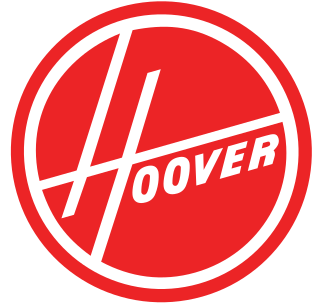
Electrolux AB is a Swedish multinational home appliance manufacturer, headquartered in Stockholm. It is consistently ranked the world's second largest appliance maker by units sold, after Whirlpool.

The Maytag Corporation is an American home and commercial appliance company. The company has been owned by Whirlpool Corporation since April 2006.

The Hoover Company is a home appliance company founded in Ohio, United States. It also established a major base in the United Kingdom; and, mostly in the 20th century, it dominated the electric vacuum cleaner industry, to the point where the Hoover brand name became synonymous with vacuum cleaners and vacuuming in the United Kingdom and Ireland. Hoover North America was once part of Maytag, but was sold by Maytag's new owners Whirlpool Corporation in 2007 to Hong Kong multinational manufacturing company Techtronic Industries for $107 million. Hoover International had already split from Hoover North America in 1993, and was acquired by Candy in 1995, which was acquired by Haier in 2019.
White-Westinghouse is an American home appliance brand used under license by trademark owner Westinghouse Licensing Corporation. It was created in 1975 when White Consolidated Industries bought the Westinghouse Electric Corporation's major appliance business. White Consolidated Industries was in turn acquired by Electrolux in 1986.

Whirlpool Corporation is an American multinational manufacturer and marketer of home appliances headquartered in Benton Charter Township, Michigan, United States. The Fortune 500 company has annual revenue of approximately $21 billion, 78,000 employees, and more than 70 manufacturing and technology research centers globally.
Hotpoint is a brand of domestic appliances. Ownership of the brand is split between American company Whirlpool, which has the rights in Europe, and Chinese company Haier, which has the rights in the Americas through its purchase of GE Appliances in 2016.

A mixer is a kitchen device that uses a gear-driven mechanism to rotate a set of "beaters" in a bowl containing the food or liquids to be prepared by mixing them.
Sunbeam Products is an American brand that has produced electric home appliances since 1910. Its products have included the Mixmaster mixer, the Sunbeam CG waffle iron, Coffeemaster (1938–1964) and the fully automatic T20 toaster.
The Amana Corporation is an American brand of household appliances. It was founded in 1934 by George Foerstner as The Electrical Equipment Co. in Middle Amana, Iowa, to manufacture commercial walk-in coolers. The business was later owned by the Amana Society and became known as Amana Refrigeration, Inc. It is now owned by the Whirlpool Corporation.

The Kenwood Chef is a food mixer developed by Ken Wood in Britain. It is a single machine with a number of attachments that allow it to perform many functions. The Chef, based on the earlier A200, was introduced in 1950. Kenwood mixers, along with most other Kenwood products were originally manufactured in the UK by Kenwood Limited. The Chef Mixer was an instant success in the UK and is still Kenwood's top seller today.

Toastmaster is a brand name for home appliances. It was originally (1921) the name of one of the world's first automatic electric pop-up toasters for home use, the Toastmaster Model 1-A-1. Since then the Toastmaster brand has been used on a wide range of small kitchen appliances, such as coffeemakers, waffle irons, toasters, and blenders.
The Hobart Corporation is an American mid-market provider of commercial grocery and foodservice equipment. The company manufactures food preparation machines for cutting, slicing and mixing, cooking equipment, refrigeration units, warewashing and waste disposal systems, and weighing, wrapping, and labeling systems and products. Hobart is an international company with manufacturing plants in the US, Brazil, Canada, China, France, Germany, Italy, and the UK.
Admiral is an American appliance brand that is currently marketed by Whirlpool Corporation and sold exclusively at The Home Depot.
The Chambers stove is a generic name for several different kitchen cooking appliances sold under the Chambers brand name from 1912 to approximately 1988. Their ranges and stand-alone ovens were known for their patented insulation methods, which enabled them to cook on retained heat with the fuel turned off.
Colston was a British electrical appliance manufacturer, founded by ex-Hoover director Sir Charles Colston in 1955, that made compact dishwashers.
JennAir is a Benton Harbor, Michigan-based designer and manufacturer of household appliances and fixtures.

FULGOR Milano is a registered trademark of Meneghetti S.p.a., an Italian manufacturer of premium major appliances and ceramic glass grills. Fulgor's global headquarters are located in Rosa, Italy; near Bassano Del Grappa in Italy's Veneto Region. The company's products compete with those made by companies Sub-Zero, Bosch, Thermador, Dacor, Miele, Viking Range, or Smeg.

Kenmore is an American brand of household appliances, cookware, floorcare, grills, HVAC equipment and other home items owned and licensed by Transformco, an affiliate of ESL Investments. Previously they were a subsidiary brand of Sears Holdings, but after Sears Holdings filed for Chapter 11 bankruptcy on October 15, 2018 they were acquired by Transformco, formed in 2019 after acquiring the assets of Sears Holdings Corporation.
Bauknecht, formally Bauknecht Hausgeräte GmbH, was one of Germany's leading manufacturers of household appliances, and since 1989 has been a brand of Whirlpool Corporation. The headquarters of the company was in Schorndorf in Baden-Württemberg until 2006 when it relocated to Stuttgart. Whirlpool has closed its three plants in Calw (refrigerators/freezers), Neunkirchen (dishwashers) and Schorndorf. Since 2012 all Bauknecht branded products have been manufactured outside Germany.

IFB Home Appliances is an Indian home appliances company and a division of IFB Industries. It has its manufacturing locations in Kolkata and Verna, Goa. The company has a chain of ~530 retail outlets called ‘IFB Point’.













